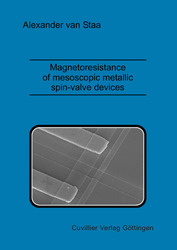| Fachbereiche | |
|---|---|
| Buchreihen (96) |
1378
|
| Nachhaltigkeit |
3
|
| Gesundheitswesen |
1
|
| Geisteswissenschaften |
2364
|
| Naturwissenschaften |
5406
|
| Mathematik | 229 |
| Informatik | 319 |
| Physik | 980 |
| Chemie | 1363 |
| Geowissenschaften | 131 |
| Humanmedizin | 243 |
| Zahn-, Mund- und Kieferheilkunde | 10 |
| Veterinärmedizin | 108 |
| Pharmazie | 147 |
| Biologie | 835 |
| Biochemie, Molekularbiologie, Gentechnologie | 121 |
| Biophysik | 25 |
| Ernährungs- und Haushaltswissenschaften | 45 |
| Land- und Agrarwissenschaften | 1004 |
| Forstwissenschaften | 201 |
| Gartenbauwissenschaft | 20 |
| Umweltforschung, Ökologie und Landespflege | 148 |
| Ingenieurwissenschaften |
1793
|
| Allgemein |
98
|
|
Leitlinien Unfallchirurgie
5. Auflage bestellen |
|
Erweiterte Suche
Magnetoresistance of mesoscopic metallic spin-valve devices
Alexander van Staa (Autor)Vorschau
Inhaltsverzeichnis, Datei (19 KB)
Leseprobe, Datei (160 KB)
Spin-polarized transport in all-metal spin-valve devices consisting of two bar-shaped permalloy electrodes and an interconnecting aluminum strip are studied in this thesis. Two different geometries are realized: one has a planar aluminum strip, the other has planar permalloy electrodes. The anisotropic magnetoresistance of the electrodes and the magnetoresistance of the entire device are measured in the same cooling cycles at liquid helium temperatures and above. The mesoscopic spin-valve effect is observed in samples with both layouts. The spin-valve effect can be clearly distinguished from parasitic effects, namely the anisotropic magnetoresistance and the local Hall effect. The magnitude of the spin-valve effect and its temperature dependence show good agreement with a theoretical estimation based on diffusive transport. The micromagnetic behavior of the permalloy electrodes is explored with a magnetic-force microscope at room temperature and with measurements of the anisotropic magnetoresistance at low temperatures. Tunnel barriers at the interfaces between the ferromagnets and the normal metal are predicted to increase the spin-injection efficiency. Therefore, the natural oxidation of aluminum in pure oxygen is studied with non-magnetic tunnel junctions. Aluminum oxide tunnel barriers are fabricated successfully both in an evaporation chamber and in a multi-target sputter-deposition system. The latter enables the in situ fabrication of high quality interfaces with aluminum oxide tunnel barriers.
| ISBN-13 (Printausgabe) | 3867279802 |
| ISBN-13 (Printausgabe) | 9783867279802 |
| ISBN-13 (E-Book) | 9783736929807 |
| Sprache | Englisch |
| Seitenanzahl | 76 |
| Auflage | 1 |
| Band | 0 |
| Erscheinungsort | Göttingen |
| Promotionsort | Hamburg |
| Erscheinungsdatum | 29.08.2006 |
| Allgemeine Einordnung | Dissertation |
| Fachbereiche |
Physik
|








